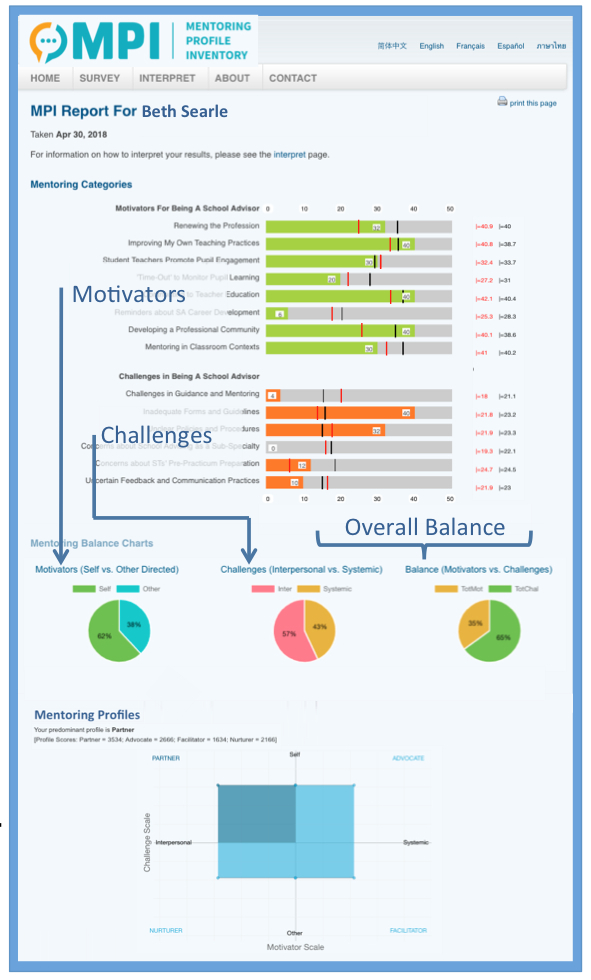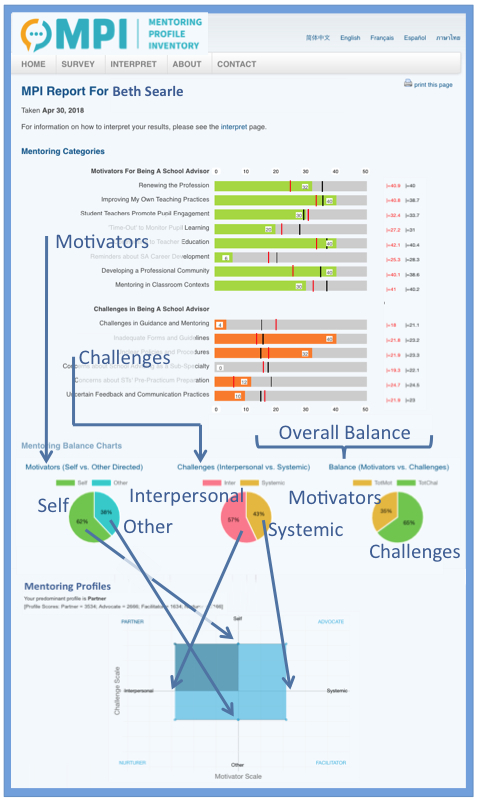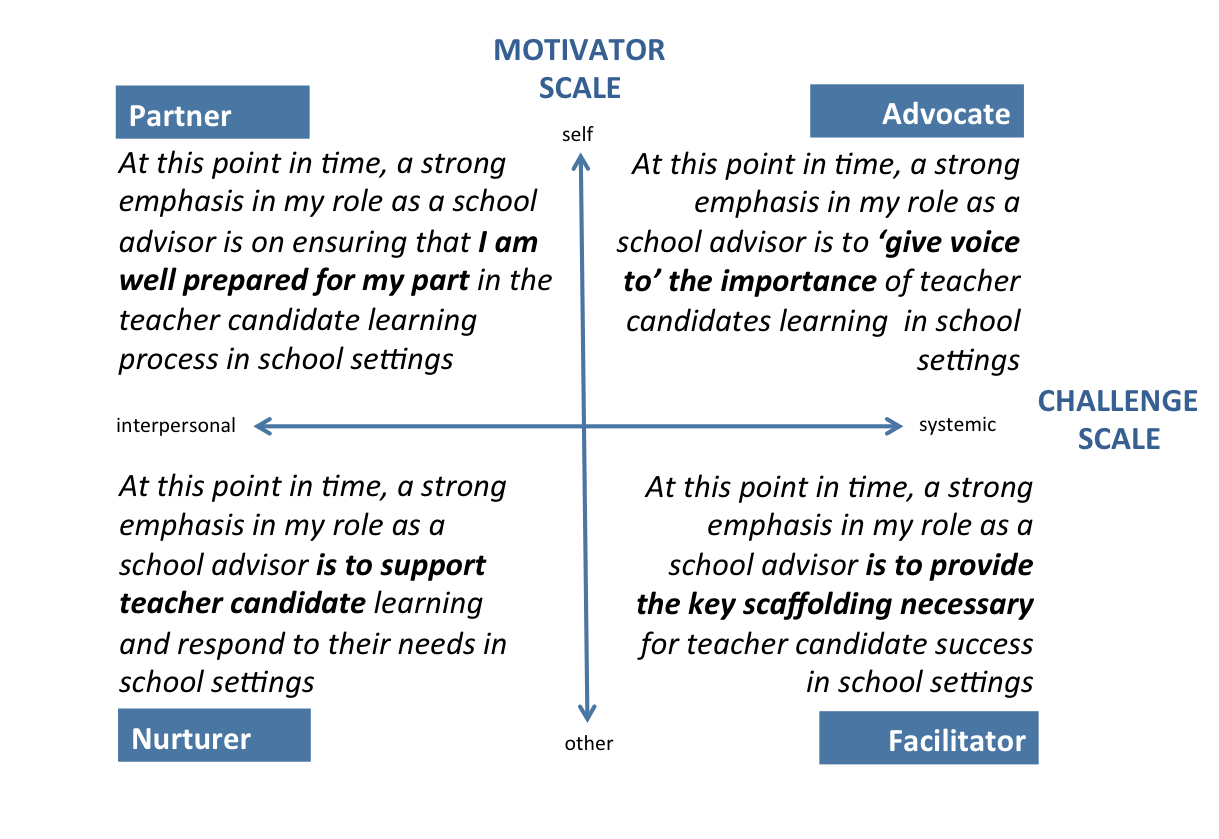Interpret Your MPI Profile
Your Mentoring Profile Inventory provides a snapshot about how you conceive your current work with student teachers. As such, it helps you identify aspects of that work that you find particularly (1) motivating or satisfying or (2) features that are challenging or problematic. Many of these motivators and challenges are things you intuitively know as you go about your work with student teachers on practicum and the MPI helps make them explicit.
Thus, the value of the MPI lies in how it helps highlight various aspects of your advisory practice for examination in an intentional and deliberative manner. The MPI provides the starting point and is meant to prompt a wider discussion of advisory practices and to promote thoughtful discussion among School Advisors, Faculty Advisors, and Student Teachers as well as between schools, school districts, and universities.
Your Profile highlights issues that are current and relevant to your practice today. Remember that supervisory practice is a dynamic reality that will change over time depending on context, experience, and knowledge. Your Mentoring Profile sheet shows you a 14-line bar chart and three pie charts.

The 14 bars summarize your overall pattern of eight Motivator dimensions and six Challenge dimensions that constitute much of School Advisors’ work with Student Teachers in practicum settings. The pie charts show you three different ways of examining your balance within and across the various dimensions: first, the within Motivator dimensions are portrayed as a balance between ‘self’ and ‘other’, second, the Challenge dimensions are portrayed as a balance between ‘interpersonal’ and ‘systemic’, and third, your overall balance between the eight Motivator and six Challenge dimensions is displayed.
The “Eight Faces of Motivation” in Mentoring and Supervising Student Teachers.
Interviews with School Advisors agree with research studies that there are many reasons why School Advisors find satisfaction and motivation in working with Student Teachers in the contexts of daily classroom and school activities. Despite the detail and complexity of these reasons, there are eight underlying dimensions that School Advisors generally agree are the major motivators for working with student teachers. These can be best described in terms of
My work with student teachers in important:
-
for Renewing the Profession
-
for Improving my own Teaching Practices
-
because Student Teachers Promote Pupil Engagement
-
because it allows‘Time-Out’ to Monitor Pupil Learning
-
for Contributing to Teacher Education
-
because it provides Reminders about Career Development
-
for Developing a Professional Community, and
-
for Mentoring Practices in Classroom Contexts.
People’s Motivator scores (green bars) can range from 0 to 50. Higher scores (longer green bars) indicate which dimensions are particularly motivating for you, low scores are those that are less so. The black lines ‘|’ are averages of other School Advisors like you. Of course, School Advisors are individuals and they differ in their thinking, experiences and work situations. Any one Advisor may find more satisfaction in some of these dimensions and less in others, so there is no “one right way to be”. The motivators bars on your Profile sheet will help you see which dimensions are more prominent for you ... and which others are not as prominent. Here is a more detailed interpretation about the meaning of each of these Motivator dimensions:
Renewing the Profession by developing the next generation of teachers is rewarding to School Advisors who believe that supervising is necessary to renew and replenish the profession of teaching, who report that producing more teachers is our social responsibility, who recognize that working with student teachers is important to education and to society in general, and who agree that school advising helps develop Student Teachers into fully-fledged teachers.
Improving my own Teaching Practices identifies School Advisors who see that supervising helps refine their own teaching practices and skills, whose Student Teachers help them refine their values and beliefs, keep them current with new ideas, and who are rewarded by explaining to their Student Teachers why they teach the way they do.
Student Teachers Promote Pupil Engagement by providing “new blood” in the classroom, thereby prompting pupil learning, enhancing pupil interest and classroom dynamics, and assisting in addressing pupil diversity in the classroom. Importantly, pupils see that student teachers are also learners – just like everyone else and the classroom is an educative environment for all.
‘Time-Out’ to Monitor Pupil Learning is helpful to School Advisors by allowing them time to pause and reflect or to have a ‘breather’ to think and observe the classroom while working, for example, one-on-one with pupils or while monitoring the classroom learning needs.
Contributing to Teacher Education is rewarding to School Advisors who enjoy coaching beginning teachers. These teachers acknowledge that working with Student Teachers ‘is the right thing to do’, is a part of their professional responsibility, and contributes to their own professional development.
Reminders about Career Development are reported by School Advisors who are mindful about their careers and are aware that school advising is a form of educational leadership. At the same time these Advisors are conscious of the dangers of self-aggrandizement and report that working with student teachers provides a window into their own practice as both a classroom teacher and a mentor to others.
Developing a Professional Community characterizes School Advisors who find it satisfying to work with other adults and to promote collaboration, collegiality and community. They recognize that supervising develops professional relationships with future colleagues and they enjoy the collective learning that arises in student teaching contexts.
Mentoring Practices in Classroom Contexts is rewarding to School Advisors who enjoy helping Student Teachers connect theory to practice, to help them work through day-to-day issues, to learn and develop, and to understand that there are many ‘right ways to teach’ in the immediacy of the action setting.
Challenges Associated with Being a School Advisor
Of course, there are challenges associated in working with Student Teachers in much the same way as there are motivators. These can be best described in terms of
My work with student teachers is challenging at times because:
-
of Challenges in Guidance and Mentoring
-
of Inadequate Forms and Guidelines
-
of Unclear Policies and Procedures
-
of Concerns about School Advising as a Sub-Specialty
-
of Concerns about STs’ Pre-Practicum Preparation
-
of Uncertain Feedback and Communication Practices
As with the Motivators, Challenge scores (orange bars) can range between 0 and 50. High scores (longer bars) indicate issues that are particularly challenging for you, while low scores suggest themes that are less of an issue. Black lines ‘|’ are scores typical of other School Advisors, but your own scores may be higher or lower than these averages. Here are more detailed descriptions of what these six dimensions indicate.
Challenges in Guidance and Mentoring are reported by School Advisors who would like some assistance in establishing what Student Teachers can expect from the relationship, in addressing and correcting STs’ misconceptions as they arise, in developing more meaningful relationships with their STs, or better articulating the evaluation process to their student teachers.
Inadequate Forms and Guidelines resulting in part from, unclear evaluation guidelines to differentiate between Student Teacher successes and failures, vague protocols for providing feedback to Student Teachers, an absence of evaluation forms which are responsive to School Advisors concerns and insights, or a lack of support for Student Teachers’ self-evaluations.
Unclear Policies and Procedures that govern student teachers’ triadic relationship resulting in a lack of clarity about the roles and responsibilities of Faculty Advisors, unclear feedback mechanisms between Faculty Advisors and School Advisors, a lack of access to university resources for Student Teachers who are struggling, or an absence of systematic procedures for selecting and preparing School Advisors or Faculty Advisors.
Concerns about School Advising as a Sub-Specialty result from the absence of a common set of expectations among a school’s School Advisors, from difficulties maintaining communication among these School Advisors, from problems helping School Advisors to resolve their own issues and doubts, or from difficulties involving other School Advisors in decision-making about the profession.
Concerns about STs’ Pre-Practicum Preparation exist in the absence of agreement about standard practices for advising Student Teachers, from scanty information about Student Teachers’ coursework or preparation prior to the practicum, or Advisory Handbooks that provide only limited guidelines, scenarios or examples.
Uncertain Feedback and Communication Practices moves beyond policy and procedures to reflect an absence of engagement between school and university administrators to inform School Advisors how well they are assisting Student Teachers, communication challenges between local school Administrators and School Advisors, communication problems within the local school staff and staff at other schools, or insufficient feedback practice from Student Teachers themselves to report what is working and what is not.
Balance on the Job: Motivation, Challenge, and Within the Profession
At the bottom of your Profile sheet are three pie charts. These indicate balance across important realities of the workplace.
The left-most chart reflects two aspects of what you reported as motivating and rewarding.
Some of what motivates School Advisors is direct and personal (Self). And there is also satisfaction in seeing others flourish and succeed (Other). The balance of light green to dark green sectors indicates the degree of emphasis between ‘self’ and ‘other’ in terms of the reciprocal benefits associated in working with a student teacher.
In contrast, some of the Challenges and Problems of School Advisor responsibilities arise from communication or feedback problems (Interpersonal) while others result from lack of clear policy, guidelines, or procedures (Systemic). The dark and light orange sectors of the middle chart indicate the degree of emphasis between ‘interpersonal’ and ‘systemic’ issues inherent in field-based components of learning a profession.
To the right, the third chart indicates how you see the overall balance of your workplace Motivators to its Challenges in working with student teachers in practicum settings.
The MPI provides a snapshot of your Mentoring Profile at this point in time and no two School Advisors will have precisely the same profiles of Motivators or Challenges. Nevertheless, the information in these scales and profiles provides a good beginning point for self-study and values-clarification individually and collectively in school settings. The MPI gives you a broader vocabulary to discuss these issues with other School Advisors, with School colleagues, with School Administrators, and with University colleagues.
Remember too, that things change. The time may come that you wish to take the MPI a second time. Or even a third to see if your insights into your School Advisor role change as circumstances evolve. It remains free and online at www.MentoringProfile.com.
MPI Grid
The MPI Grid is derived from four scores: 'self', 'other', 'interpersonal' and 'systemic'. These scores are mapped onto a set of Motivator and Challenge axes as shown below.

The resultant image demonstrates the emphasis that you place on one or more of four possible mentoring roles in your current practice: Advocate, Facilitator, Supporter, or Partner. The four roles are defined as follows:

